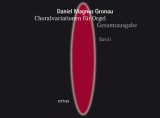
Choralvariationen für Orgel - Gesamtausgabe
Artikelnummer
OM195
Kompositör
Gronau Daniel Magnus
1250 kr
In the course of their long-term research on the organs and organ music of historical Danzig the two organists Martin Rost and Krzysztof Urbaniak in October 2012 made a sensational discovery: Among the holdings of the Newberry Library (Chicago) they located a microfilm, produced in 1981, of a large volume of chorale variations by Daniel Magnus Gronau (ca. 1700–1747) formerly owned by the Danzig St. John’s Church and considered lost since 1945.
The enormous musicological significance of the manuscript, which had been discovered by Hermann Rauschning in the archives of St. John’s in Danzig in 1909, was pointed out as early as the 1920s by the Danzig organist and musicologist Gotthold Frotscher. Frotscher copied six of the chorale cycles and published a discussion and partial transcription of Gronau’s detailed registrations.
Because of the devastations of World War II, and as after 1945 the valuable manuscript was presumed irretrievably lost, a systematic evaluation of the source was never undertaken. Before the autumn of 2012 therefore only the six cycles copied by Frotscher were known, as well as a number of registrations conveyed by him. The microfilm now proves that at least at the time it was produced the original volume of Gronau’s works still existed, even though its present whereabouts are unknown. The microfilm now enables us to attempt a new assessment of Gronau as a composer and adds to the northern German organ repertoire of the first half of the 18th century the most substantial collection of organ chorale settings transmitted from that period. In addition, the registrations are an indispensable source of information on the performance practice of 18th-century German organ music. We are convinced that a thorough study of Gronau’s registrations will serve as an encouragement to leave the beaten tracks and reconsider the established dogmas governing the accepted combinations of stops.
2 vol., softcover, XLIX + pages 1-198 (vol. 1), IV + pages 199-439 (vol. 2)
The enormous musicological significance of the manuscript, which had been discovered by Hermann Rauschning in the archives of St. John’s in Danzig in 1909, was pointed out as early as the 1920s by the Danzig organist and musicologist Gotthold Frotscher. Frotscher copied six of the chorale cycles and published a discussion and partial transcription of Gronau’s detailed registrations.
Because of the devastations of World War II, and as after 1945 the valuable manuscript was presumed irretrievably lost, a systematic evaluation of the source was never undertaken. Before the autumn of 2012 therefore only the six cycles copied by Frotscher were known, as well as a number of registrations conveyed by him. The microfilm now proves that at least at the time it was produced the original volume of Gronau’s works still existed, even though its present whereabouts are unknown. The microfilm now enables us to attempt a new assessment of Gronau as a composer and adds to the northern German organ repertoire of the first half of the 18th century the most substantial collection of organ chorale settings transmitted from that period. In addition, the registrations are an indispensable source of information on the performance practice of 18th-century German organ music. We are convinced that a thorough study of Gronau’s registrations will serve as an encouragement to leave the beaten tracks and reconsider the established dogmas governing the accepted combinations of stops.
2 vol., softcover, XLIX + pages 1-198 (vol. 1), IV + pages 199-439 (vol. 2)
PDF
